Photo by Richard Best
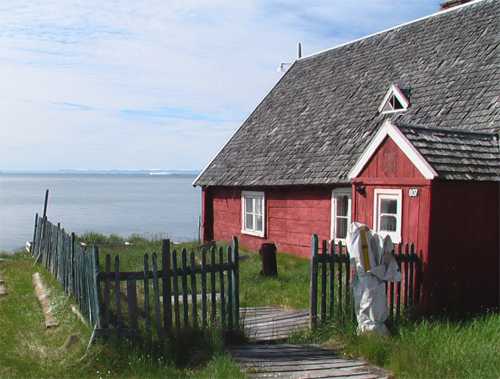 |
Photo by Richard Best
Kayak design and technique have been brought to a high art in the Arctic, where a mistake is likely to be fatal. Sea kayakers in the USA and Europe are increasingly interested in the traditional approach. We look at this in various places on the Kayarchy website - see the links on the right. For an excellent resource on all things about Greenland kayaking, see www.qajaqusa.org and click here for additional links.
Kayaks and the similar baidarkas were already in use 3,500 years ago, from Greenland to the Aleutian Islands.
Modern recreational sea kayaks probably owe most to West Greenland design. And to how few designers... even today, the total population of Greenland is only 57,000. In his book Watkins Last Expedition (Chatto & Windus 1934), F Spencer Chapman noted that his friend Kidarsi "although an excellent wood-worker, is getting his uncle to make his new kayak: so specialized is the construction that the good hunters prefer to get their kayaks made by one of half-a-dozen noted experts".
We are told that Eskimo, as in Eskimo kayak, Eskimo roll or Eskimo rescue, is not a popular word in Greenland, so we haven't used it in this website.
Thank you to Richard Best for photos of Greenland here and elsewhere in the Kayarchy site.
We would like to expand this chapter in future editions so contributions are particularly welcome. See Get In Touch. If you're from Greenland and would like to contribute a section about your kayaking, or correct anything we've said, please write in. We'll be glad to hear from you.
Many waves of settlers have moved across the north of Canada and perhaps half a dozen have reached Greenland. The most recent arrivals from the west were the Thule Inuit. They were preceded by those known by archaeologists as the Dorset culture or Palaeo-Eskimos, and by the Inuit as the Tornit or Tuniit. Spreading out from what is now north-east Canada via Baffin Island and Ellesmere Island, they reached Greenland more than 2000 years ago.
In 980-990 AD the first European settlers of southern Greenland found abandoned villages which seem to have been built by Dorset culture people.
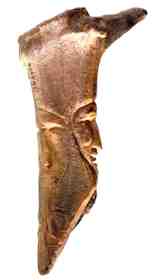 There are more questions than answers about the Dorset culture. Physically, they probably looked like today's Greenlanders. They made superb small stone tools such as lance heads, burins and many objects which to the untrained eye look exactly like Neolithic arrowheads. However the general opinion seems to be that the use of bow and arrow was not widespread. They did not have dogs but it seems they did have skin-on-frame boats. Carvings of kayaks have been found at Dorset sites. They used toggling harpoons to hunt seals and walrus. They hunted polar bear and were expert catchers of fish and birds. They produced beautiful small carvings of animals, birds and human faces. The one on the left is one of the best-known later carvings. It is one of a few which show a long European-style face, in a striking contrast with the usual Dorset carvings of rounder faces. It is thought that it may represent an early Norse explorer.
There are more questions than answers about the Dorset culture. Physically, they probably looked like today's Greenlanders. They made superb small stone tools such as lance heads, burins and many objects which to the untrained eye look exactly like Neolithic arrowheads. However the general opinion seems to be that the use of bow and arrow was not widespread. They did not have dogs but it seems they did have skin-on-frame boats. Carvings of kayaks have been found at Dorset sites. They used toggling harpoons to hunt seals and walrus. They hunted polar bear and were expert catchers of fish and birds. They produced beautiful small carvings of animals, birds and human faces. The one on the left is one of the best-known later carvings. It is one of a few which show a long European-style face, in a striking contrast with the usual Dorset carvings of rounder faces. It is thought that it may represent an early Norse explorer.
For more, and many images of artefacts, see the Canadian Museum of Civilization at www.civilization.ca
Before about 900 AD, the ancestors of the Thule Inuit lived in northern Alaska. They used kayaks, harpoons which detached after penetrating the skin of a seal or whale but left the body attached to the harpoon line, and umiaks, which are skin-on-frame open boats able to carry heavy loads. For archive photos like this one, go to Arktiske Billeder and search on konebåd or umiak:—
Here's a recent photo by Richard Best. It is said that traditional umiaks were flat-bottomed like the fisherman's dory used on the Grand Banks and that rounded underwater shapes were adopted only after the Inuit had seen European whaleboats:—
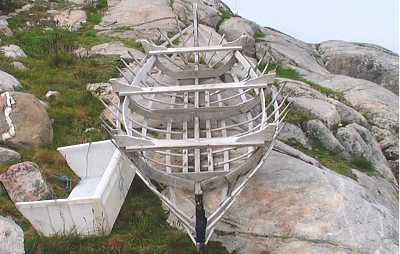
The Inuit also had powerful and accurate recurve bows. Like Mongol bows, the Inuit bow was of composite construction. The bow stave had a semi-rigid element (made of wood, whalebone, caribou antler or walrus ivory) which was strong in compression. To this they attached a full-length flexible backing of braided sinew which was strong in tension. The backing was fixed to the bow stave on the side opposite the bow string. When the archer drew the bow, the backing was put in tension. It greatly increased both the power of the bow and the speed with which the arrow left it. Inuit archers were able to kill caribou, musk ox and polar bear. For more, see the Holman Museum section of www.virtualmuseum.ca. In particular, www.virtualmuseum.ca/Exhibitions/Holman/english/includes/popup.php3?needle=P12. The following site is also interesting but the text is only in Danish. www.natmus.dk at http://tinyurl.com/3ch6zb
On the coast of Alaska, the population grew. Fighting started between groups competing for a share of local resources. The ancestors of the Inuit started a migration into the east. On Ellesmere Island and in north-west Greenland they encountered the Dorset culture.
The Dorset culture faded out completely not long afterwards. The reasons are unclear and it was not necessarily as a result of conflict. They survived long enough to trade with the Inuit and to pass on elements of their culture.
As the Inuit spread down the west coast of Greenland they came into contact with Norse settlers who had set up small farming communities in sheltered fjords in the south west and who supplemented their income by sailing north to hunt seal and walrus. The Inuit, and possibly the Dorset culture, traded with them and fought them.
As time went by, a cooling climate caused the Norse settlers to abandon Greenland and forced the Inuit to give up living permanently in the north. They remained in the south, mainly on the west coast.
If you go to Arktiske Billeder you will find a free online database of 40,000 photos taken in Greenland between 1860 and 1960. Search on kajak for hundreds of photos including building and repairing kayaks, hunting equipment, fishing from a kayak, and catching seals, walrus and a shark.
This kayak model was made some time in the 19th century, of the same materials as a real kayak and complete with full hunting equipment,

Greenland is part of the kingdom of Denmark but has its own parliament and is not a member of the European Union. The population is only 57,000, most of whom live in towns on the west coast. Most are of Inuit descent, often with some genetic input from 11th century Norse settlers or modern Danish settlers. 12% of the population are of Danish descent.
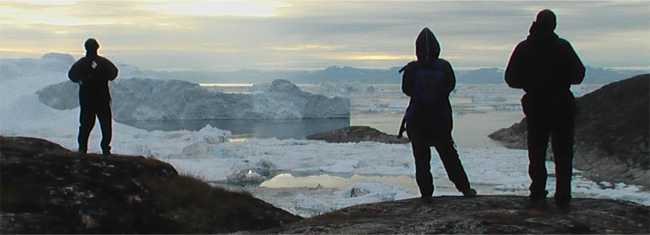
Photo by Richard Best
According to the Greenland Tourism & Business Council / Greenland Home Rule / Nanoq at www.greenland.com "the kayak... is almost 4000 years old... [and] has been an essential piece of hunting equipment for Inuits in Greenland and the rest of Arctic North America. The kayak has been used in connection with sealing, whaling and fishing...the traditional 'qajaq' is still seen in many towns and especially at the annual kayak meetings, but for recreational kayaking the more robust sea kayaks made of fiberglass have gradually taken the place of the traditional versions."
You can still go to Greenland and see dozens of skin-on-frame kayaks. Richard again:

Sea kayaks currently on sale in Europe include the Odin, the Drakken and two called Viking. We wondered if a Viking ever sat in a kayak, and found a collection of scholarly essays published by the Smithsonian Institution Press as Vikings: The North Atlantic Saga. Good book, great illustrations. The answer is that Vikings may well have tried kayaking but there is no record or direct evidence of it.
The Norse certainly had canoes of their own design, little double-ended wooden open boats. In about 900 AD an aristocratic Swedish lady was buried at Årby Gård, a farm near Uppsala, with a small canoe. 13 feet long by 41 inches wide it had both paddles and oars, and a movable seat to give comfortable sitting positions for paddling or rowing. If a faering (four-oared boat) is a miniature Viking longship / drakkar, the Årby boat is a miniature faering. Several museum replicas have been built by specialist craftsmen from oak planks bent and cut to the right curve. If you want to try yourself, the lines are available in several places on the internet. The original had only two wide planks per side, plus a narrow horizontal plank for the bottom. If you want to build a plywood reinterpretation, you could get a similar shape and appearance if you're willing to make the planks narrower. Try a Google image search on "Årbybåten".
Vikings may have tried kayaks. It has been suggested that kayaks on a pattern similar to those used elsewhere in the Arctic may have been used by coastal Lapps (Sami) in the north of Norway itself, but we have little information about that.
The Norse certainly saw Greenland kayaks in Norway. The Danish geographer Claudius Clausson Swart, writing in the 1430s, said that he saw displayed in Trondheim Cathedral a long skin boat of a sort from which "pygmies" had been captured in Greenland or the far west.
Norse settlers were present in Greenland from 982 AD to 1350 or perhaps 1450, and their hunting parties would have seen Thule Inuit kayaks in Disko Bay.
The homeland of the Vikings was, of course, Scandinavia. They saw themselves primarily as farmers. By 870 AD, population pressure in Scandinavia was sending Norse settlers west to Iceland. By 930, Iceland itself had little room for new settlers. Certainly by the 980s all the worthwhile farmland had been carved up, leaving the less fortunate to work as tenant farmers or laborers. In 982 a frustrated Norseman, Erik the Red, was looking for new horizons. He had been banished from Norway for unacceptable violence and got into more trouble in Iceland. Having heard that a land existed west of Iceland, he sailed there with his family and followers.
While all this was going on, an eastward migration of Inuit whale hunters had reached Greenland, but only the north-west. Erik and his followers found locations in the south-west which were capable of supporting sheep, cattle and goats. In 985, Erik sailed back to Iceland to spread the word that this "Greenland" was worth settling. Hundreds of Icelanders accepted his invitation to join him. When they arrived, the climate was enjoying a mild spell. They found good hunting and fishing, and a fair amount of good farmland in sheltered locations at the heads of several fjords, but very few trees capable of supplying wood for building or fuel. In time, Erik's son Leif and daughter Freydis explored into Canada and North America from an advanced base at L'Anse Aux Meadows in northern Newfoundland. They found timber, iron and grape vines but were thwarted by the presence of well-armed native Americans and fell back on Greenland.
The main Viking settlement was near Erik's own farm of Brattahlid at the inner end of Eriksfjord in the south west of Greenland. His wife Thjodhild got him to build a small Christian church there. Substantial other settlements were set up at the inner end of fjords near what is now Nuuk. According to Wikipedia, the Norse community in Greenland got its own Christian bishop and cathedral 140-odd years after Erik arrived. "The first bishop of Garðar, Arnaldur, was ordained by the Archbishop of Lund in 1124. He arrived in Greenland in 1126."
The Norsemen had to import many things from Scandinavia and Britain, including bronze, iron and the charcoal they needed to smelt it, pottery and glass. They would have lived a very poor life if they had not been able to pay for these things by exporting walrus skin rope, walrus ivory and narwhal tusks. The ivory in particular fetched a good price as it was used for the manufacture of luxury products such as jewellery, crucifixes and chess sets.
The Greenland Norse seem to have traded with the Inuit, and perhaps also with people of the Dorset culture across the water in Baffin Island. Their goods were traded on even further afield. In 1957, an 11th century Norse coin was excavated from a midden as far south as Brooklin, Maine, which was then a large native American village where several trade routes met.
The Norse probably got most seal and walrus by hunting them rather than by trade with the Inuit. Although they had good reason to respect the abilities of the Inuit, and plenty of opportunity to see Inuit hunting technology, they already considered themselves to be expert hunters and sailors and did not generally adopt Inuit techniques.
Oral history in Greenland states that at least one group of Norse settlers gave up farming and took up a subsistence hunting lifestyle, co-operating with nearby Inuit families. It seems probable that they would have tried kayaking.
Greenlandic oral history also recounts instances of Norse women and children taken into Inuit families after their men died in hunting accidents or fights. Today's Greenlanders seem to have inherited some Old Norse words and woodworking techniques. In particular, the hook scarf joint used by kayak builders to make two short pieces of wood into one long one.
As a community, the Norse settlers did not adopt Inuit techniques, tools or weapons. They might have done better if they had. A few toggling harpoons have been excavated from Norse settlements, but nothing like the number found everywhere in Inuit grave sites and settlements.
As time went by, the climate deteriorated. By 1350 the Norse farmers were finding it difficult to produce enough hay to keep even goats alive during the cold dark months of winter. Things were rough in Scandinavia and Britain too, as successive plague years reduced their populations. To the Greenland Norse, plague in Europe meant a smaller export market for their northern luxuries, but it also meant an opportunity to acquire good farmland in a warmer and sunnier climate.
There were probably no more than three thousand Norse settlers in Greenland at any one time and the average population level was probably only half that. As things got tougher some left, some stayed and died.
It may have been a factor in the eventual extinction of the Norse settlements that they continued to use their own less efficient hunting technology. This probably reflects the Vikings' attitude towards possession of land and animals as a measure of status and wealth; their corresponding lack of respect for "skraelings", a derogatory word they used to refer to both the Inuit and other native Americans; and the influence of resident bishops whose wealth was largely in livestock. Whatever the reason, there is no evidence that a Viking ever sat in a kayak.
"In 1931, at Cape Farewell, Watkins met an Eskimo who had recently been blown out to sea for four days in a phenomenal storm: he had had to roll his kayak many times".
F Spencer Chapman, Watkins' Last Expedition, 1934
There are many old accounts of kayakers reaching the coasts of Scotland and the Netherlands. Often, they died shortly after landing. This was taken to be the result of exhaustion but may have been the effect of European diseases to which they had no immunity.
These incidents have been explained as the arrival from Greenland of storm-driven Inuit. It has also been suggested that kayaks were used by coastal Lapps (Sami) in the north of Norway who might have reached the Netherlands or Scotland under their own power.
Another possibility is that they were Inuit who had been kidnapped by European sailors and whalers, and brought back to Europe with their equipment. There is some evidence for this.
In about 1000 AD Thorfinn Karlsefni, one of the original settlers of Greenland, kidnapped two boys in Markland (probably Labrador), taught them the Norse language and had them baptized. He probably took them back to Scandinavia. There was already a vigorous slave trade in Europe. Basque, Breton, and Portuguese adventurers operated in northern waters and it is probable that they captured local people and took them back as slaves to supplement to their load of cod and whale products. Exploring northern waters, Jacques Carier kidnapped native Americans and took them to France. Detailed records still exist in Spain and Portugal of the market in slaves from Europe, north and south America, Africa and further afield. In 16th century Lisbon, one could buy slaves captured in Newfoundland and Labrador.
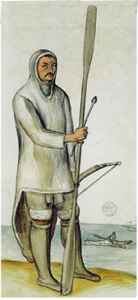 |
The British explorer Martin Frobisher kidnapped several Inuit during his 1576-77 voyages to Baffin Island. The first was captured while still seated in his kayak. He died of a chest infection within two weeks of arriving in London but not before being painted in watercolor by the Flemish artist Lucas de Heere. He is shown here wearing a tuiliq, with paddle, bow and arrow and a kayak in the background. When Frobisher went back he kidnapped another three. In 1603, British sailors in Virginia kidnapped Powhatan Indians with their canoes and had them put on a canoeing exhibition on the Thames. |
In Africans & Native Americans (University of Illinois Press) Jack Forbes states that "by 1566 Inuit people could be seen in the Hague... the massive growth of the whaling industry as well as the activities of the Danish government led to many Inuit along with their kayaks being taken to Europe, principally to Denmark, the Netherlands and whaling centers.... Between 1605 and 1725 quite a number of Inuit were taken specifically to Denmark, Holland and Friesland. From these places a number managed to escape in their kayaks."
There are more than a dozen 17th or 18th century kayaks on display in museums in the Netherlands. One in the maritime museum of Zierikzee is explained by the attractive legend that Zierik, who founded the town, arrived at the site in a kayak in 849 AD. When Victor Hugo visited as a tourist in 1867 he was told that the kayak and its drowned owner had been found on the beach a century earlier. Another possibility is that it was part of a collection of Greenland kayaking equipment brought back to the Netherlands by Nicolaas Tunes in 1656.
In Scotland, particularly in Aberdeen, several kayaks can be seen which arrived with their Inuit owners in the 18th or 19th century. They were either brought from Greenland by whalers or captured off the coast of Scotland. One which arrived in the 18th century is preserved with paddle, harpoon, bird spear and throwing stick. Returning from a whaling trip to Labrador in 1839, a Captain Penny brought an Inuit to Aberdeen with his kayak aboard the ship Neptune. Eenoolooapik put on a kayaking show in the River Don but died of tuberculosis the following year. Several of these kayaks can still be seen in the Aberdeen University Medical School, or online at the Marischal Virtual Museum, www.abdn.ac.uk/virtualmuseum/index
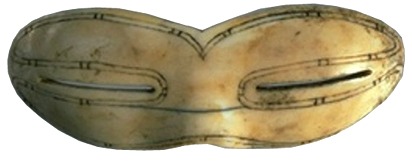
Go to next page for:
• Sea kayaking technique